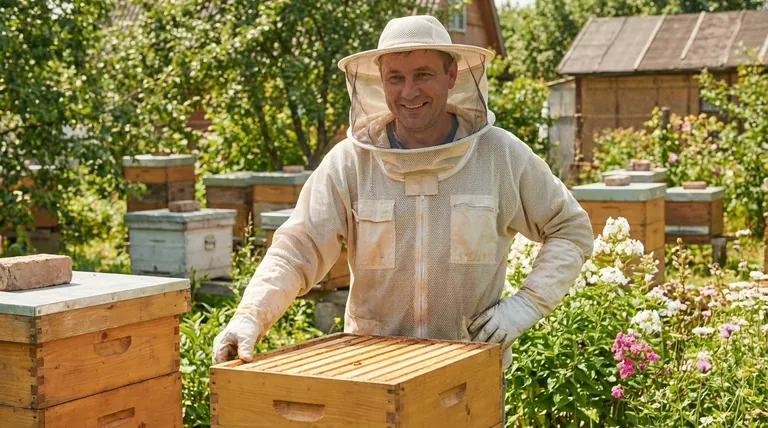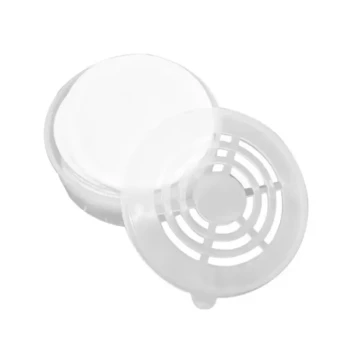For maximum comfort in a beekeeping suit, look for features that promote ventilation and a customized fit. The most comfortable suits are typically made from a triple-layer mesh or aerated fabric that allows for airflow, combined with adjustable elements like elastic waistbands, thumb ties, and robust zippers to ensure the suit moves with you without being restrictive.
The core challenge is balancing absolute protection with the physical demands of working in the heat. True comfort isn't about softness; it's a technical outcome of superior ventilation, a secure-yet-unrestrictive fit, and thoughtful design features that remove minor annoyances.

Beyond Protection: The Pillars of Beekeeping Comfort
While protection is a suit's primary function, comfort is what allows you to work effectively and enjoy your time with the bees. This comfort is built on three key pillars.
The Critical Role of Ventilation
The single biggest complaint about beekeeping suits is heat retention. Modern suits directly address this with specialized materials.
Look for suits advertised as ventilated or aerated. These are often made of a triple-mesh construction, a layered fabric that allows air to circulate freely while keeping bees out. This design makes a significant difference in hot climates.
Achieving a Secure, Unrestrictive Fit
A suit that is too tight will be restrictive, while one that is too loose can bunch up and be cumbersome. A proper fit is essential for comfort and safety.
Seek out adjustable features that allow you to customize the fit to your body. Key elements include an elasticized waistband or drawstring, which prevents the suit from sagging and creates a secure seal.
Crucially, check for strong elastic in the ankles and wrists. This is vital for blocking bee access, but a quality elastic will provide a secure seal without cutting off circulation.
Quality-of-Life Design Features
Small details can have a huge impact on your comfort and focus during a hive inspection.
A high-quality suit will include thumb ties or loops. These small elastic bands hook over your thumb to keep the sleeve from riding up when you put on your gloves, preventing a common and dangerous entry point for bees.
Also, inspect the zippers. A strong front zipper is essential for durability, and a well-designed integrated veil with its own zipper system makes the suit easier to put on and take off.
Understanding the Trade-offs
Choosing a suit involves balancing cost, durability, and comfort. The primary trade-off you will face is between traditional materials and modern ventilated fabrics.
Ventilated Suits: The Gold Standard for Hot Climates
These suits offer unparalleled comfort in the summer heat. The constant airflow significantly reduces the risk of overheating, allowing you to work longer and more comfortably.
The primary downside is often cost, as the multi-layer fabric is more complex to manufacture. However, for any beekeeper in a warm region, the investment is almost always worth it.
Traditional Cotton Suits: The Dependable Workhorse
Standard cotton or poly-cotton suits provide excellent protection and are highly durable. They are often the most budget-friendly option, making them a common choice for beginners.
Their major drawback is low ventilation. On a hot, sunny day, a cotton suit can quickly become an oven, leading to discomfort and fatigue. While effective for protection, they are not optimized for comfort in the heat.
Making the Right Choice for Your Goal
Select your suit based on your climate and how frequently you plan to work your hives.
- If your primary focus is maximum comfort in warm weather: Prioritize a ventilated or triple-mesh suit to ensure the best possible airflow.
- If your primary focus is a budget-friendly or infrequent-use option: A traditional cotton suit offers great protection, but be mindful of the potential for overheating on hot days.
- If your primary focus is function and preventing annoyances: Regardless of material, choose a suit with thumb loops, a robust zipper system, and an adjustable waist.
Ultimately, the right suit is one that makes you feel confident and comfortable, allowing you to focus entirely on the health of your bees.
Summary Table:
| Feature | Purpose | Benefit |
|---|---|---|
| Ventilated / Triple-Mesh Fabric | Promotes airflow | Reduces heat stress and fatigue in warm weather |
| Adjustable Waist & Elastic Cuffs | Creates a secure, custom fit | Prevents bee entry without restricting movement |
| Thumb Loops / Ties | Secures sleeves in place | Eliminates a common bee entry point and annoyance |
| Robust Zipper System | Ensures easy on/off and durability | Provides reliable protection and long-term value |
Equip Your Apiary for Maximum Comfort and Efficiency
For commercial beekeepers and equipment distributors, the productivity of your operation depends on the comfort and confidence of your team. An uncomfortable suit leads to shorter hive inspections and increased fatigue.
HONESTBEE supplies high-performance beekeeping suits and equipment designed for the demands of professional beekeeping. Our wholesale-focused operations ensure you get the durable, well-ventilated suits your business needs at competitive prices.
Let's discuss how our suits can enhance your operation's safety and efficiency.
Contact our wholesale team today to request a quote and find the right solution for your apiary.
Visual Guide

Related Products
- Wholesales Dadant Size Wooden Bee Hives for Beekeeping
- Yellow Plastic Bucket Pail Perch for Beekeeping
- Professional Insulated Plastic Bee Hives
- Long Langstroth Style Horizontal Top Bar Hive for Wholesale
- Professional Insulated Winter Hive Wrap for Beekeeping
People Also Ask
- How often should the area under beehives be inspected and cleaned during the warm season? A Proactive Maintenance Guide
- What should you do if you find an ant nest near your beehive? Essential Strategies for Hive Protection
- What types of products are available for beekeeping needs? Essential Equipment for Apiaries & Distributors
- Why were wooden hives traditionally preferred? For Natural Beekeeping Aligned with Bee Biology
- What is beekeeping equipment? Essential Tools for Commercial Apiaries & Distributors



















